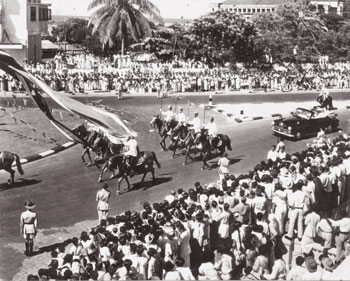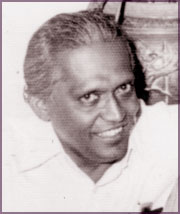|
Down memory lane: Celebrations on the first Day of
Independence :
Hallowed was the day, forever bright its memory...
Aditha Dissanayake
The most important secular holiday on our calender, the only time in
the year when the entire nation congregates in celebrations, observing
Independence Day with religious events and fanfare dates back,
(naturally) to the first Day of Independence on February 4, 1948.
"Colombo was robed in a mantle of splendour" was the headline of the
Sunday Observer of February 5, 1948. The lead story covering the full
length of the cover page described the day in flowery language.
|

Morning of February 4, 1948; Duke of Gloucester's state
drive from Queen's House to Independence Halle to declare
Independence Pic; L.E Samararatne |
"Ceylon's first day of independence, yesterday opening on a note of
religious fervour and sober thanksgiving, steeped up as the day
progressed in an atmosphere of joyous abundance culminating in a mammoth
water pageant in Colombo's harbour the first of the series of
celebrations which will now proceed in a crescendo to a climax of the
opening of parliament on February 10.
It was long after midnight when the last belated reveler of the many
thousand who flocked to the Fort area to view the illuminations and
water pageant wended wearily back to bed."
The day had begun with crowds flocking in their thousands to places
of warship with his Excellency the Governor General himself attending
the service at the Wolvendhal Church. Religious services were also held
at the Maligakanda Temple, St. Lucias Cathedral and the Maradana mosque
attended by religious leaders. Large number of colourful processions too
were seen through out the morning.
|

L.E Samararatne, ANCL photographer who captured the
celebrations on February 4, 1948 |
After the religious observances the crowds had looked for other
entertainment and till evening the Dehiwala Zoo and the Colombo Museum
had turned into the biggest attractions.
Songstress Vivien Boralessa remembers the senate building which
presented an imposing spectacle and was the main attraction in the city.
She further recalls singing the then National Anthem, dressed in a
lama-sari to the distinguished gathering on Independence day. "I was
seventeen at the time and a student at the Maradana Central. Master
Lionel Edirisinghe was our teacher, and I played the estraj while
singing the anthem".
Proving that somethings never change, back in 1948 too, motorists had
their share of trouble on this day and had experienced one of the worst
traffic jams in the history of the island. It had taken a car forty-five
minutes to proceed from the Galle Face Hotel to the Lake House. Exist
from the city had been just as impossible with a car journey from Fort
to Bambalapitiya taking three hours.
At Negombo, M. Fernando, Chairman of the Urban Council had hosted the
National Flag on the rampart of the Old Dutch Fort, while M.K.T Sandys,
Government Agent for Sabaragamuwa had hoisted the national flag to the
accompaniment of Magul Bera.
Mahinda Dissanayake, a retired school principal in Galle recalls the
celebrations that took place at the town hall with the attendance of the
Mayor, the forces and school children. "I was twenty-two at the time and
it was after seeing the independence day celebrations that I began to
take an interest in the political situation of our country.
The event spurred me to take an active part in politics later on in
my life". He recalls vividly how he listened to the Prime Minister's
speech on the radio, read by Cyril Attygalle, Member of Parliament
followed by translations in Sinhala and Tamil.
According to Nozomi Kariyasu," The necessity of a National Flag was
discussed even before Sri Lanka gained independence on February 4th,
1948. A. Sinnalebbe, MP for Batticaloa tabled a motion in the State
Council on January 16th, 1948 suggesting that the Lion Flag of King Sri
Wickrama Rajasinghe which was taken to Britain in 1815 should be made
the National Flag.
This was debated and later Prime Minister Rt. Hon. D.S. Senanayake
had named an Advisory Committee for the formulation of a National Flag.
The Members of the Committee were S.W.R.D. Bandaranaike (Chairmen), Sir
John Kotalawela, J.R. Jayewardene, T.B. Jayah, Dr. L.A. Rajapakse, G.G.
Ponnambalam, Senator S. Nadesan, and Dr. Senarath Paranavithana
(Secretary)."
Although a Committee for the formulation of a national flag was
appointed no finality had been reached when the first Independence Day
was celebrated on February 4th, 1948. However the Lion Flag fluttered on
that day.
The Lion Flag and the British Union Jack fluttered on the occasion of
the opening of the first Parliament of independent Sri Lanka (then
Ceylon) on February 11th, 1948. Prime Minister D.S. Senanayake unfurled
the Lion Flag at the Octagon (Pattirippuwa) during the Independence
celebrations held in Kandy on February 12th, 1948.
Here is how the Time magazine of February 23, 1948 describes the
celebrations in an article titled "Lion for Lion".
"For 2,000 years the Lion flag of Kandy waved defiantly over the
Indian Ocean island of Ceylon. Under it the Sinhalese Buddhist kings
struggled and connived with invading princes and rival island chieftains
for uncertain sovereignty over their huge (25,000 sq. mi.) island of
blue mountains, green jungles and yellow sands. Then Ceylon became a
British Crown colony, and in 1815 the Lion of Kandy was hauled down to
make room for another, more famous member of his species.
Last week, the British Lion was still in Ceylon, but only as a guest.
In a Buddhist ceremony in Kandy as old as the island's history,
golden-robed chieftains and 100 richly caparisoned elephants (decked in
ruby necklaces and white pantaloons) paraded the streets in dressy
dignity to celebrate a new independence.
Jasmine-decked maidens and bare-breasted Sinhalese youths with bells
on their ankles whirled in ancient dances.
Then, before Britain's Royal Duke & Duchess of Gloucester (who had
travelled from London for the occasion) and 150,000 of Ceylon's six
million-odd Eurasians, Indians, Sinhalese, Tamils, Moors and Malays,
rugged, 6 ft., 63-year-old Prime Minister Don Stephen ("Jungle John")
Senanayake hauled the old Lion flag to its place atop the Temple of the
Tooth." Down memory lane...to all those who remember the country's first
Independence celebrations - hallowed was the day, forever bright its
memory.
[email protected]
|

